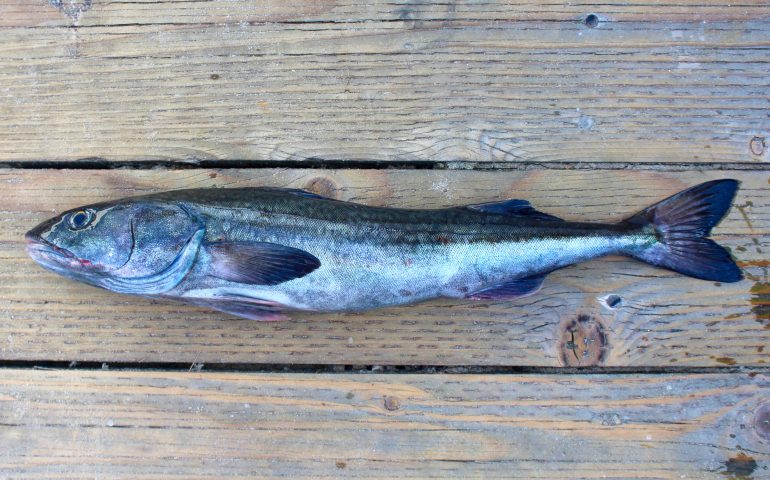Sablefishes and Skilfishes: Family Anoplopomatidae
Species: Anoplopoma fimbria (Pallas, 1814); from the Greek words anoplis (unarmed) and poma (operculum or gill cover), and the Latin word fimbria (fringe).
Alternate Names: Commercially called blackcod in Washington and butterfish in California. Other names include Alaska blackcod, coalfish, coal cod, candlefish, black candlefish, bluecod, deep sea trout, zipperfish, sable, skil-fish, skil, and skill. Called t’thémekwe by the Salish in British Columbia, sqel or skil by the Haida, and hádání by the Heiltsuk. Called bacalao negro in Mexico.
Identification: Elongate (cod-shaped) tapering to the tail. Two widely spaced dorsal fins. Adult coloring is variable, usually black, blackish-gray, or greenish-gray on the back and sides, gray to white below. Young fish taken from piers are generally pale greenish-colored on top and sides fading to white.
.
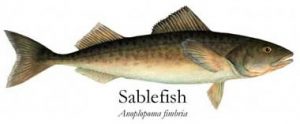
Adult Sablefish
Size: To 46 inches and 56 pounds although most caught from piers are young fish under a foot in length. Sablefish can live to about 55 years of age so the bigger fish are generally old fish. The IGFA World Record fish weighed 35 Lbs. 3 oz.and was caught bat Cross Sound, Elfin Cove, Alaska in 2013.
Range: Bahia San Bartolome, southern Baja California, Islas San Benito and Isla Cedros, central Baja, California, California north to Alaska, Aleutian Islands and Bowers Bank to Bering Sea south of Saint Lawrence Island, Alaska, Hatsu Shima Island, southern Japan; usually in extremely deep water. Common from Banco Ranger, central Baja California to the Aleutian Islands, Alaska, Kuril Islands, Russia, and the Sea of Okhotsk (between Russia and Japan).
Habitat: Adult fish are caught in deep water, often over a thousand feet deep and they’ve been recorded to a depth of 8,989 feet. Prefer areas of blue clay or mud. Young fish, to a foot long or so, are often found in fairly shallow areas, especially to the north. There is also a difference in habitat north and south; in southern California, sablefish are almost always found in deep-water areas, in northern California, Eureka north, sablefish will sometimes be found in shallower water.
Piers: Sablefish are rarely seen at California piers although piers adjacent to deep-water canyons may see a few each year. Best bets: Newport Pier, Balboa Pier, Redondo Beach Pier, and Monterey Wharf No. 2. In the far north, where sablefish become a more shallow-water fish, they will sometimes show up during the summer months in Humboldt Bay and a few will fall to anglers fishing from Eureka area piers. I have also seen small specimens taken from the Pismo Beach Pier, the Capitola Wharf, and Monterey Wharf #2, all in central California.
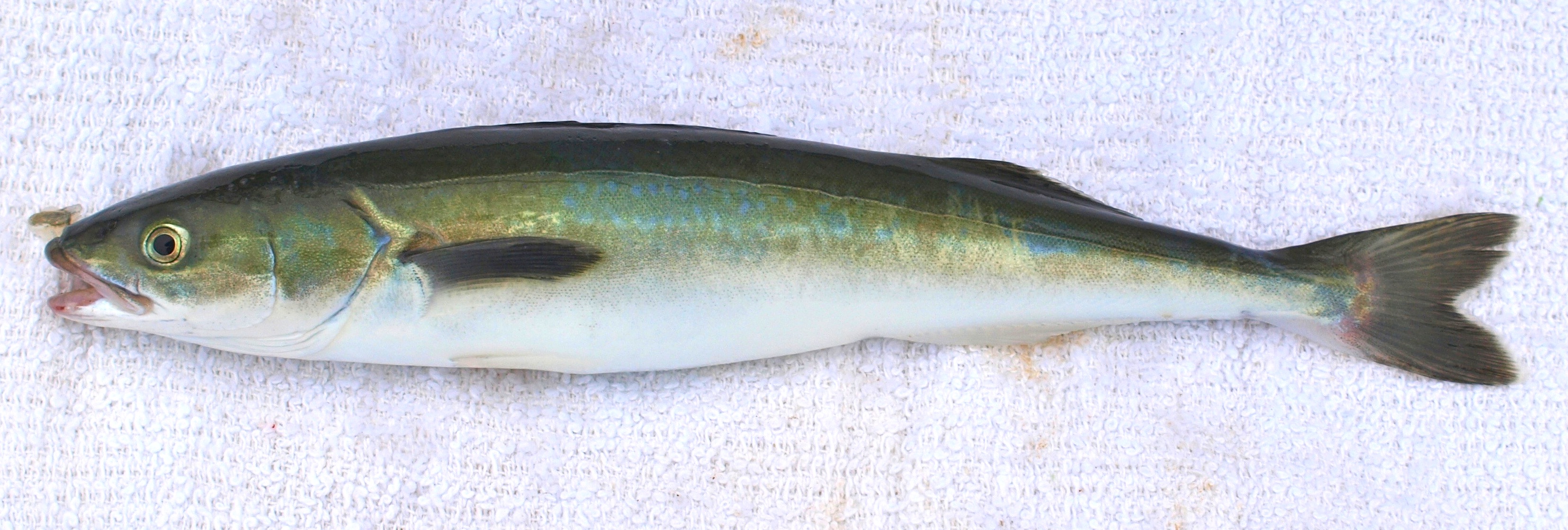
Small sablefish from the Monterey Wharf #2
Shoreline: Rarely taken by shore anglers.
Boats: Rarely taken by boaters in southern California although they’re commonly taken by rockcod anglers fishing in deep waters off Santa Cruz and Monterey.
Bait and Tackle: On piers a high/low rigging baited with strips of squid is the preferred method. On boats they are generally taken on typical rockcod tackle.
Food Value: Adult sablefish an excellent quality fish with a moderate buttery flavor, firm texture, large flakes and high fat content. They are one of the best tasting smoked fish. In fact, many people, including myself, like the rich buttery flavor of sablefish better than salmon. For a period of time when I worked in the corporate world one of the areas I visited was Seattle and I soon found a fish restaurant on the waterfront, Ivar’s Acres of Clams, that served smoked sablefish. That one dish prompted several additional visits. They are rarely seen on restaurant menus although I have seen smoked sablefish for sale in Santa Cruz, Morro Bay and Fort Bragg. In addition, fresh sablefish is one of the staple items at the dory fleet at the foot of Newport Pier (although you need to get there early in the morning before the fish are sold out). Unfortunately the young sablefish that occasionally visit piers are not quite as rich flavored. Nevertheless they are still best smoked or broiled, methods that give the buttery flavor a chance to show itself. Do not, repeat, do not, pan-fry or deep-fry sablefish. The results will be an inferior piece of over oily meat.
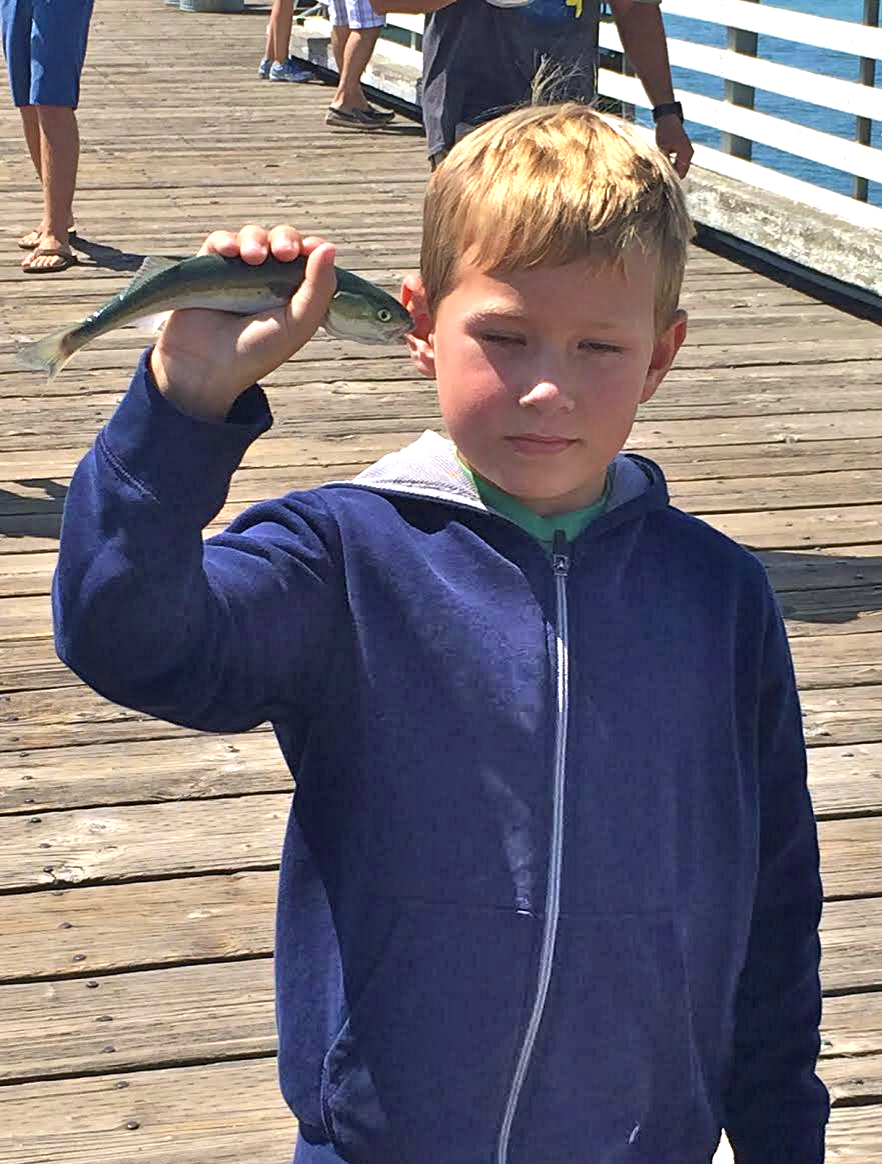
Small sablefish from the Pismo Beach Pier
Comments: Sablefish are one of my favorite fish simply because they are an uncommon treat! My first big day pier fishing took place at the Newport Pier in September 10, 1962 and involved sablefish. I had arrived, as usual, at the crack of dawn, and was fishing just down from the northwest corner. I was using squid for bait and had experienced very little early success. However, around 5:30 A.M., I had a strike and pulled in an ebony-colored fish—a type I had never caught before. The next cast yielded two more of these strange colored fish and I continued to catch fish, nearly every cast, for the next two hours. Strangely, only two other anglers were having similar success. Most anglers were going fishless at Newport. Later, I found out the fish were sablefish, a deep-water fish more common to northern waters. Upon cleaning the fish, I also found the reason for my success. The fish were stuffed with squid that were schooling in the waters near to the pier. Anglers who were using squid for bait, and there were only a few, were catching the fish. I caught 47 sablefish that day, but it was only a start. I continued to catch fish: large jacksmelt, Pacific mackerel and jack mackerel—77 fish in all. And, quite appropriately, I also caught a small squid. It was, mirabile dictu, one of the best days I ever had at the pier even though the fishing probably would have been considered poor for most of my fellow anglers that day. Six weeks later, on October 27, saw the catch of six additional sablefish although this time it was in the evening. It was the only times I have ever caught sablefish at a pier.
As said, sablefish are a deep-water fish and generally only encountered if you are fishing really deep waters. During the ’70s, I frequently fished on the Stagnaro rock cod boats (Stagnaro #1 and Stagnaro #2) out of the Santa Cruz Wharf and we would fish some deep-water reefs. Occasionally, when the boats would drift over a muddy area, we would pull in some big sablefish and some big Pacific hake. No one wanted the hake but everyone wanted the sablefish.
Another place where I caught them was from one of California’s last fishing barges, the California, that was based in Redondo Beach. A trip in July 1978 saw the barge anchored near the edge of the Redondo Submarine Canyon and saw me catch five sablefish (if you catch one you’ll usually catch more) during a full night of fishing that produced 77 fish of six different species.
As for piers, the first mention I have of them was at the Santa Cruz Wharf in 1932. “Charles Bellinghausen landed yesterday a fish seldom caught with hook and line, a deep sea cod, also known as black cod, Alaskan cod and sable fish.” —Santa Cruz Sentinel, September 30, 1932
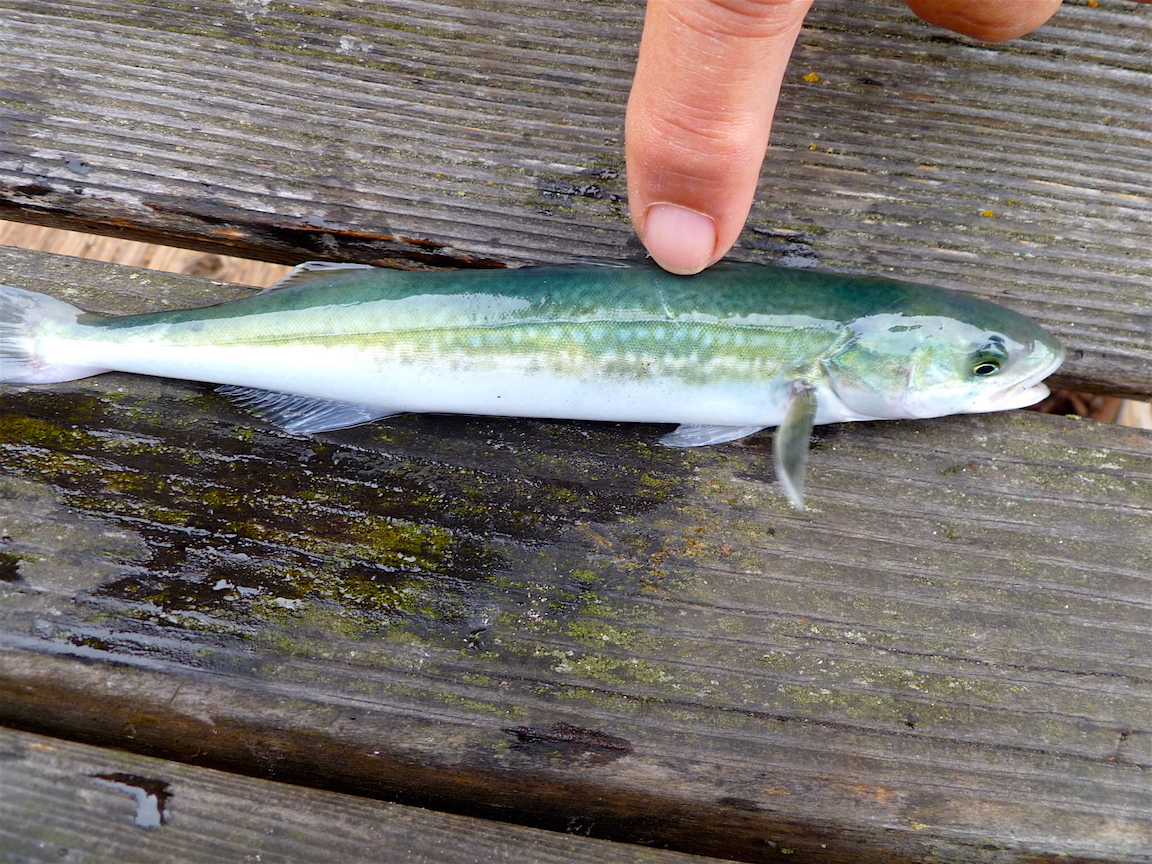
A small sablefish caught from the Capitola Wharf
Perhaps the best example of deep-water fish showing up at a California pier was a run of sablefish that took place at Wharf #2 in 1947. The numbers of both fish and anglers seems unbelievable—but the invasion was well documented!
Sablefish Run At Monterey Bay
For the first time in history, sablefish (Anoplopoma fimbria) appeared in vast numbers in the vicinity of Monterey and were caught by the thousands from the municipal pier. The run was first discovered on the afternoon of July 11th; word of the bonanza spread rapidly, and the pier was soon crowded with anglers. Men, women, and children stood shoulder to shoulder, with a varied assortment of tackle, all hauling in fish as fast as they could throw in their lines. Boxes, sacks, five-gallon cans, and washtubs were rapidly filled with 12 to 20-inch fish.
Slack periods occurred during the morning and again in the afternoons, but they were of short duration usually lasting only half an hour or less; then the fish would be back seemingly in greater numbers than before. Each day the pier would be jammed with crowds of from 2,000 to 3,500 fishermen and spectators, some having driven as far as 200 miles.
On July 26th, the run stopped as abruptly as it had begun, and although over 5,000 fishermen were on hand the next day, only a few fish were caught. During the 15 days of the run, the Bureau of Patrol Division of Fish and Game, estimated that over 110 tons had been landed.
— Keith W. Cox, Bureau of Marine Fisheries, California Division of Fish and Game, September, 1947
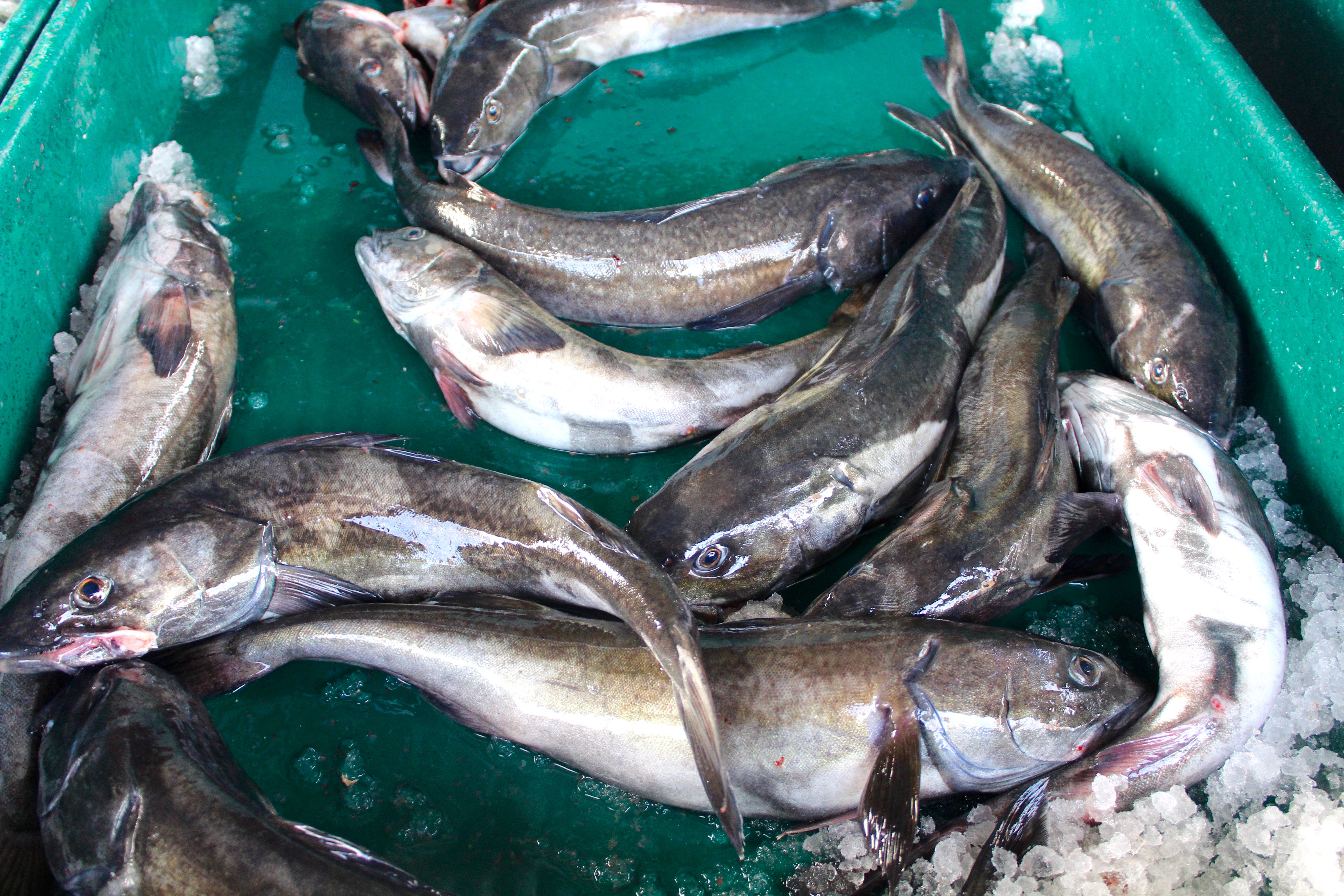
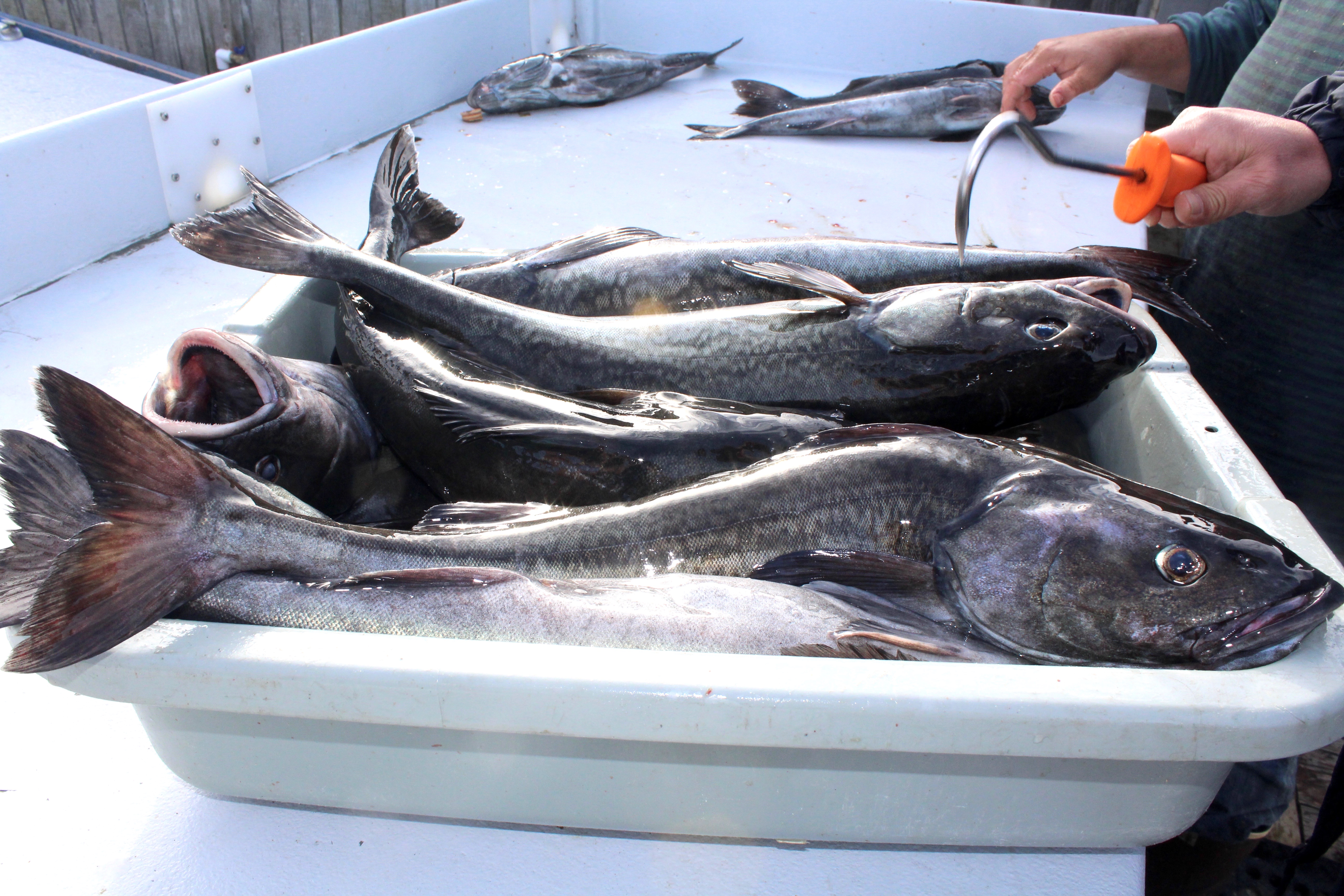
Sablefish such as these are one of the targeted species by the dory fleet next to the Newport Pier.
